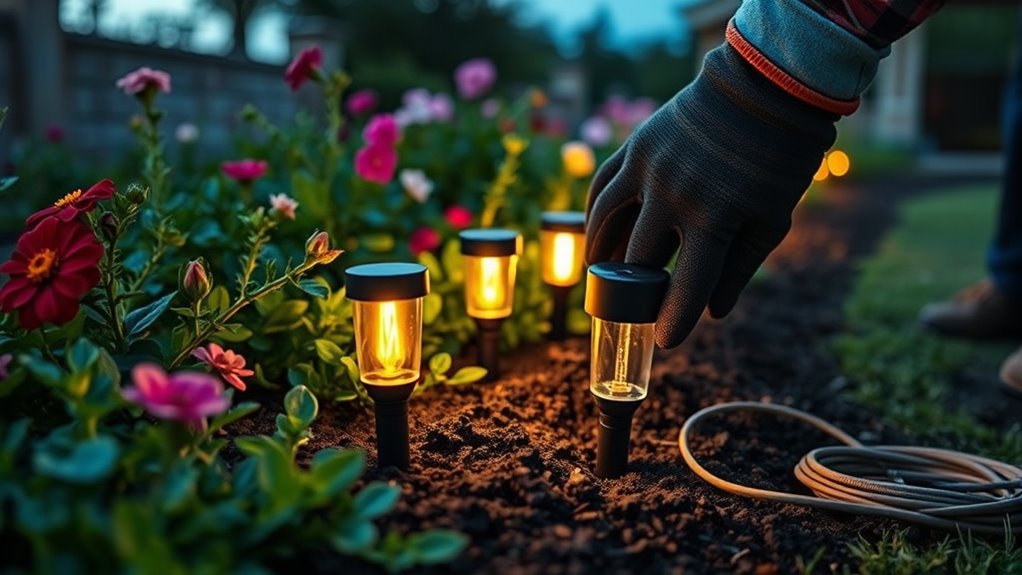To install outdoor garden lights, start by planning your layout to highlight pathways, trees, or flower beds. Choose solar-powered fixtures for easy, wire-free installation and position solar panels where they get direct sunlight. Secure lights with stakes or brackets and angle them for maximum coverage. Use timers to automate lighting schedules, and test everything before final placement. For a beautiful, low-maintenance setup, follow these steps—you’ll discover more tips along the way.
Key Takeaways
- Plan your garden layout, identifying areas for illumination and safety, and choose appropriate fixtures and power sources.
- Select solar-powered lights and position solar panels in direct sunlight for optimal charging.
- Use timers to automate lighting schedules, ensuring convenience and energy efficiency.
- Secure fixtures with stakes or brackets, angle them properly, and connect to timers if needed.
- Test the system, make necessary adjustments, and ensure all components are securely installed for durability.

Ever wondered how to transform your garden into a stunning nighttime oasis? Installing outdoor garden lights is the perfect way to do it, and it all begins with planning your setup carefully. Start by evaluating your garden’s layout and deciding which areas you want to highlight or illuminate for safety, ambiance, or aesthetic appeal. Once you’ve mapped out your lighting plan, you can choose the right fixtures and power sources to bring your vision to life.
One of the easiest and most energy-efficient options is to use solar panels. These are a smart choice because they harness sunlight during the day and convert it into electricity to power your lights at night. Solar-powered garden lights don’t require wiring or an electrical outlet, making installation simpler and more flexible. You can place solar lights along pathways, around flower beds, or to accent trees and shrubs without worrying about extension cords or complicated wiring. Just ensure the solar panels are positioned in direct sunlight during the day to maximize their charging capacity. As the sun sets, these lights automatically turn on, providing a charming glow that enhances your garden’s beauty.
To guarantee your garden lighting works seamlessly and turns on and off at the right times, consider incorporating light timers. Light timers allow you to automate your outdoor lighting schedule, so you don’t have to remember to switch them on or off manually. You can set specific times for your lights to turn on at dusk and go off at dawn, creating a consistent and inviting atmosphere every night. Many timers are compatible with solar lights, but check the specifications to ensure they match. This combination of solar panels and light timers offers a low-maintenance, eco-friendly way to enjoy beautifully lit outdoor spaces without increasing your energy bills.
When installing your lights, start by positioning solar panels in locations that get plenty of sunlight, and secure your fixtures in stable, accessible spots. Use stakes or mounting brackets to secure fixtures safely, and ensure they’re angled correctly to illuminate your desired areas. Connect your lights to the timers, if needed, and test everything before finalizing your setup. This way, you can make adjustments to optimize the lighting effects and guarantee everything functions smoothly.
Additionally, exploring energy-efficient lighting options can further enhance your garden while reducing electricity consumption. With a bit of planning and the right equipment, your outdoor garden lights will transform your yard into a nighttime haven. Solar panels and light timers work hand in hand to create an efficient, stylish, and hassle-free lighting system. Before long, you’ll be enjoying enchanting evenings outdoors, surrounded by a beautifully illuminated garden that feels magical and inviting.
Frequently Asked Questions
What Types of Bulbs Are Best for Outdoor Garden Lighting?
When choosing bulbs for outdoor garden lighting, you want options that excel in bulb durability and energy efficiency. LED bulbs are the top choice, offering long-lasting performance and consuming less power. They withstand weather conditions well and won’t need frequent replacements. Incandescent bulbs are less durable and less energy-efficient, making them a poor choice for outdoor use. Opt for LED to keep your garden beautifully lit with minimal maintenance and energy costs.
How Do I Maintain Outdoor Garden Lights Over Time?
You’re right on the money when it comes to maintaining outdoor garden lights; it’s a routine that pays off. To keep them shining bright, you should schedule regular timing maintenance and check for any damage. Replace bulbs as needed, especially before the holiday season or growing season. Clean fixtures gently with a soft cloth, and guarantee connections stay tight. A little upkeep now saves you from bigger headaches down the road.
Are Solar-Powered Garden Lights Effective in All Weather Conditions?
Solar-powered garden lights can be effective in many weather conditions, but their performance depends on solar panel durability and weather resistance features. You should choose lights with sturdy, weather-resistant designs to withstand rain, snow, and wind. Keep in mind that prolonged cloudy days may reduce brightness, but overall, well-made solar lights with durable panels and strong weather resistance features can reliably illuminate your garden year-round.
What Safety Precautions Should I Take During Installation?
Did you know that many outdoor injuries occur due to electrical hazards during installations? To stay safe, always turn off power before starting, and use proper tools designed for outdoor wiring. You should also wear insulated gloves and goggles. Carefully follow instructions, avoiding shortcuts. This proactive approach minimizes risks, ensuring your garden lighting setup is safe and effective. Remember, safety always comes first when working with electrical components outdoors.
Can Outdoor Garden Lights Be Installed Without Professional Help?
You can definitely do DIY installation of outdoor garden lights if you’re comfortable with basic electrical work. Make sure you understand the necessary tool requirements, like wire cutters, screwdrivers, and possibly a voltage tester. Follow safety precautions carefully, such as turning off power before starting and checking local codes. With proper planning and caution, you won’t need professional help, just a little patience and attention to detail.
Conclusion
Now that you’ve learned how to install your outdoor garden lights, you’re all set to transform your backyard into a stunning oasis. With a little effort, you can turn night into day and create a welcoming atmosphere for friends and family. Remember, a journey of a thousand miles begins with a single step, so don’t wait for the perfect moment—start brightening your space today and enjoy the beauty that awaits when the sun goes down.









